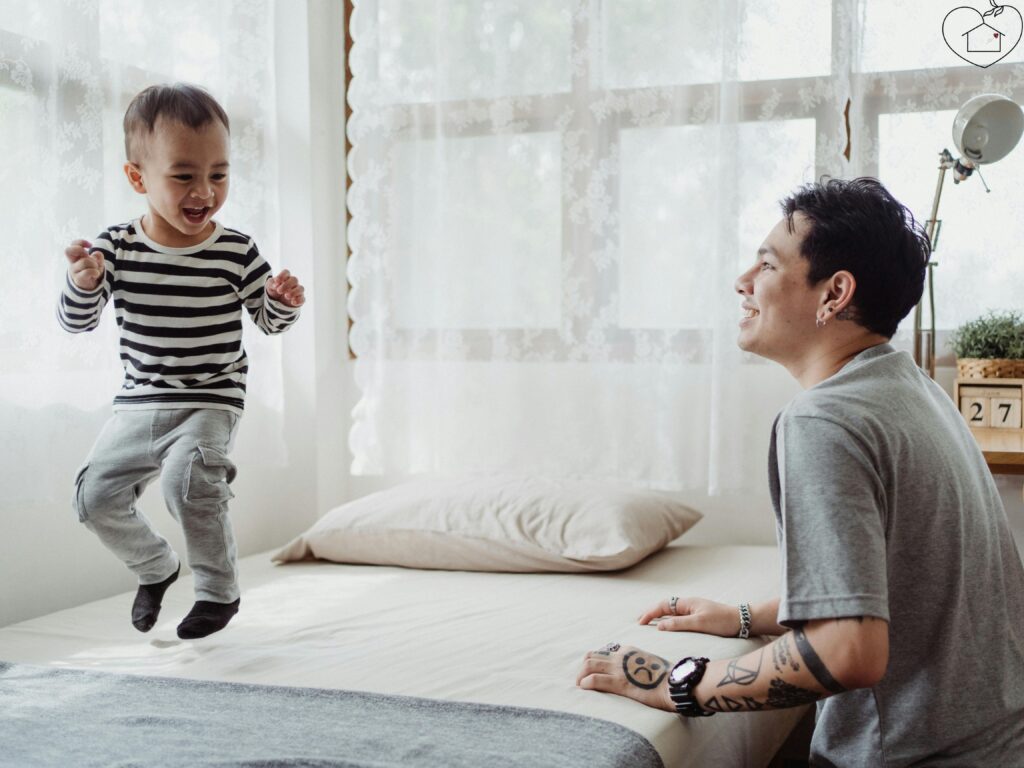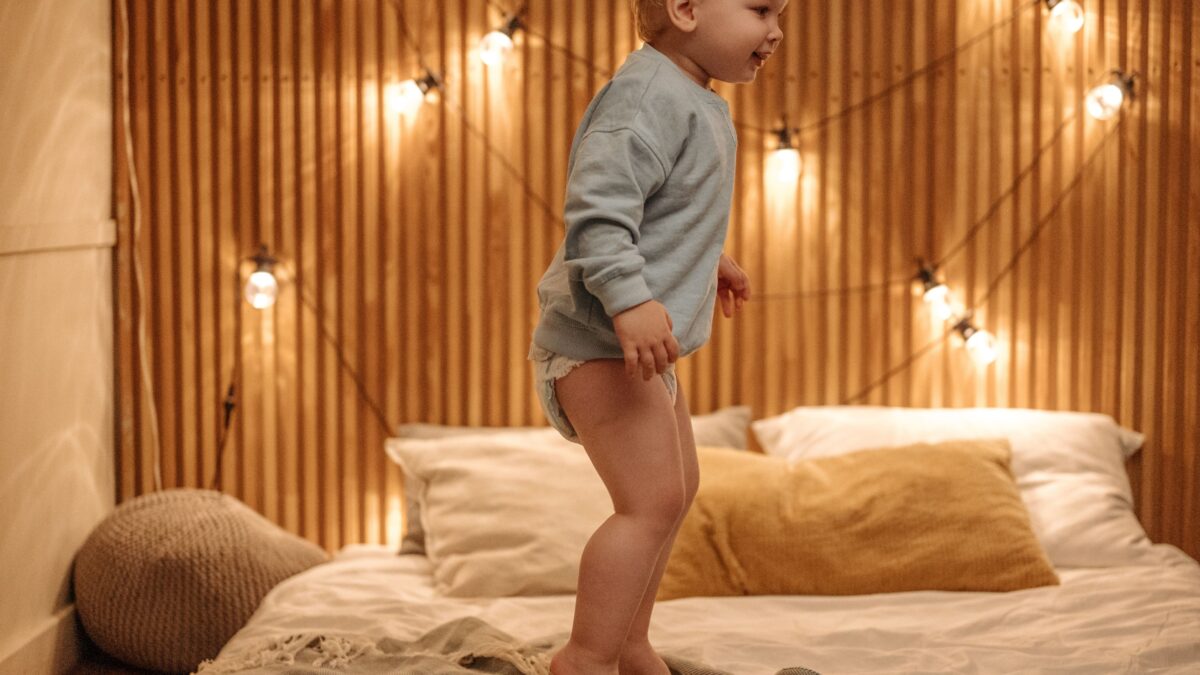One of the biggest milestones in a toddler’s development is transitioning from a crib to a toddler bed. Many parents wonder when to transition to a toddler bed and whether their child is ready for this change. Moving from a crib to a bed is not just about age—it’s about recognizing the signs of readiness, guaranteeing a safe environment, and making the transition as smooth as possible. Timing is crucial, as transitioning too early can lead to sleep disruptions, while delaying it for too long might hinder a child’s growing independence. In this article, we will examine when to transition to a toddler bed, the reasons behind this change, psychological wisdom, and essential parenting tips for supporting toddlers’ developmental needs.
Table of Contents
ToggleWhen to Transition to a Toddler Bed?
There is no one-size-fits-all answer to this question, as each child develops at their own pace. However, most toddlers transition to a bed between 18 months and 3.5 years old. The ideal time depends on the child’s physical, emotional, and cognitive development, as well as their sleeping habits.
Signs that a toddler is ready to transition include:
- Climbing out of the crib – If a child frequently climbs over the crib rails, it becomes a safety hazard, making a toddler bed a safer option.
- Showing interest in big-kid beds – Some toddlers express a desire to sleep in a bed like their older siblings or parents.
- Growing too big for the crib – If the child is physically outgrowing the crib, it’s time to switch to a more comfortable sleeping arrangement.
- Potty training progress – If a toddler is potty training and needs to get up at night to use the bathroom, a toddler bed allows for easier access.
- Consistent sleep patterns – If a toddler has established good sleep habits, the transition to a bed will likely be smoother.
While some parents may want to transition their child early, it is essential to consider whether the child is developmentally ready. Rushing the process can lead to sleep resistance, bedtime anxiety, and night-waking.
Psychological Perspective on the Transition to a Toddler Bed
From a psychological standpoint, transitioning to a toddler bed is a significant milestone in a child’s emotional and cognitive development. It represents a shift in independence, autonomy, and self-regulation.
According to attachment theory, children form strong emotional bonds with their caregivers and their environment. A crib often provides a sense of security, so moving to a new bed can create temporary anxiety. If a child is not emotionally ready, they may resist bedtime or experience separation anxiety.
Children between 2-3 years old start developing strong sleep associations according to cognitive theory. If the transition is handled poorly, it can disrupt their established sleep routine. Using positive reinforcement and creating a bedtime routine can help reinforce a child’s sense of security in the new bed.
10 Essential Parenting Tips for Supporting Toddlers’ Developmental Needs

1. Establish a Consistent Bedtime Routine
Toddlers thrive on predictability and routine. A consistent bedtime routine—such as reading a book, taking a warm bath, and using soft lighting—signals to the child that it’s time to sleep. Avoid screen time before bed, as blue light can interfere with melatonin production.
2. Offer Comfort and Reassurance
Moving to a new bed can feel overwhelming for a toddler. Providing comfort objects, such as a favorite stuffed animal or blanket, can ease the transition. Parents should also reassure their child by staying calm, using a soothing tone, and providing gentle encouragement.
3. Use Positive Reinforcement
Encouraging a toddler’s new sleeping arrangement through positive reinforcement can make the process smoother. Celebrate small successes, such as staying in bed all night, with verbal praise, stickers, or a special bedtime story.
4. Guarantee the Bedroom Is Safe and Toddler-Friendly
Since toddlers now have more freedom to get in and out of bed, their bedrooms should be child-proof. Anchor heavy furniture, cover electrical outlets, and remove potential hazards. If necessary, install a baby gate to prevent nighttime wandering.
5. Encourage Your Toddler’s Independence
Transitioning to a toddler bed is a big step for independence. Encouraging small decisions—like letting them pick out their new bed or choose their favorite blanket—helps toddlers feel a sense of ownership over the transition. Additionally, allowing them to dress themselves, brush their teeth, or pick a bedtime story builds confidence. Providing choices within limits (e.g., “Do you want to sleep with the blue blanket or the red one?”) gives them a sense of control while keeping bedtime structured.
6. Be Patient with Sleep Regression
Even if your toddler was a great sleeper before transitioning to a new bed, they might experience sleep regression. They may resist bedtime, wake up frequently, or climb out of bed multiple times. This is normal. Instead of reacting with frustration, calmly reassure them and lead them back to bed each time. Avoid creating new habits, such as letting them sleep in your bed, as this can prolong the adjustment period. Staying consistent and patient is key to overcoming sleep regression.
7. Avoid Making the Transition During Major Life Changes
Toddlers thrive on routine and familiarity, so avoid transitioning to a toddler bed during other big life changes. If your child is starting daycare, potty training, moving to a new house, or welcoming a new sibling, it might be best to delay the transition until they feel more emotionally secure. Too many changes at once can lead to resistance, anxiety, and sleep disruptions.
8. Set Clear and Gentle Bedtime Rules
Establishing clear expectations helps toddlers understand what is expected at bedtime. Create simple rules such as:
✔ Stay in bed after storytime.
✔ If you wake up at night, call for Mommy or Daddy instead of leaving the room.
✔ Lay down quietly with your stuffed animal.
Using a reward chart or positive reinforcement (e.g., “If you stay in bed all night, you get a sticker!”) can help toddlers adjust to new rules in a fun and encouraging way.
9. Help Your Toddler Self-Soothe
When toddlers wake up at night, they often rely on a parent to comfort them back to sleep. Teaching self-soothing skills helps them settle back down independently. Strategies include:
- Giving them a comfort object like a favorite stuffed animal.
- Playing soft white noise or calming music to create a familiar sleep environment.
- Encourage them to take deep breaths or hug their blanket when they feel restless.
- By gradually stepping back from nighttime soothing, toddlers learn how to fall back asleep on their own.
10. Celebrate the Milestone and Make It Fun
Turning the toddler bed transition into a positive experience can ease any anxiety. Talk about it excitedly, refer to them as a “big kid,” and celebrate small successes—like sleeping in their bed all night. Let them feel proud of this big milestone! Parents can also use books or TV shows featuring characters moving to a big-kid bed to make the experience relatable and exciting.
Watch and Read!
- “The Happy Sleeper” by Heather Turgeon & Julie Wright
- “It’s Time to Sleep in Your Own Bed” by Lawrence Shapiro
- “Big Bed for Giraffe” by Michael Dahl
- “Goodnight Moon & Other Sleepytime Tales” (2008)
- “Llama Llama Red Pajama” (Netflix Series)
- “Daniel Tiger’s Neighborhood: Big Enough to Help” (PBS Kids)
FAQs
Most children transition between 18 months and 3.5 years old. However, the right time depends on the child’s physical and emotional readiness rather than age alone.
To make the transition smoother, introduce the bed gradually, involve the child in choosing bedding, maintain a consistent bedtime routine, and offer reassurance. Avoid making the change during major life events, such as moving homes or welcoming a new sibling.
If your toddler frequently gets out of bed, it’s essential to stay calm. Gently guide them back to bed, but avoid giving too much attention to the behavior. Additionally, using a nightlight, playing soft music, or implementing a reward chart can help encourage your toddler to stay in bed. By combining these strategies, you can create a more peaceful bedtime routine.

